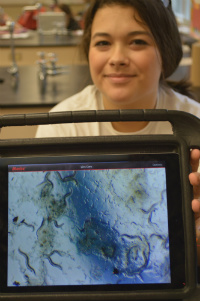Senior Collin Rinks learned it takes the right lighting, warm water and plenty of food to put zebrafish in the mood to breed.
Senior Kendra Wroten and Brazilian exchange student Mariana Paixao have spent the semester using teeny-tiny mesh to pin down daphnias — tiny water fleas — to determine how certain drugs affect their heart rates.
Those are just two projects going on in Lowell High School science teacher Heather DeJonge’s research class, the goal of which is to teach students to think like scientists.

“It’s all about showing them how scientists use persistence, self-motivation and self-direction to achieve,” DeJonge said. “They see how meticulous the process of research is, and why developing cures and drugs can seem so slow, because it takes years to do this research.”
Real-life Research
And what students learn can affect research going on right now, she said. For one project, for example, DeJonge’s class is partnering with the Van Andel Institute to study neurodegenerative disease — specifically, Parkinson’s.
Seniors Corah Kaufman and Tiana-Marie Peavy have the meticulous task of transferring microscopic Caenorhabditis elegans — known as C. elegans or more commonly, roundworms — from one plate to another by plucking them with an ultra-fine pick while looking through a microscope.
Their goal is to keep them alive, Corah explained, so they can try to determine when “a see-through bubble” on the worms’ backs signal that they have reached puberty.
“The thought is if we can delay the aging process, then we can work on delaying the symptoms that those with Parkinson’s and other diseases have,” DeJonge said.
And in some cases, aging itself is the condition being studied.

“I’m doing defecation — watching worms poop,” said junior Channing Perry, who explained that stool, the universal byproduct of the digestive tract, is often a major indicator of overall health. “We don’t want someone living a long life and having a terribly unhealthy life.”
And the thought that what he learns watching worms poop might one day lead to research that makes people healthier? “Kind of sweet,” Channing said. “It encourages you to focus and to get as correct data as you can.”
The research class got its start last year as an after-school club. An official class was created through the partnership the high school has with the Van Andel Institute’s Van Raamsdonk Laboratory. The institute’s Employee Impact Campaign fund provided some $22,000 in equipment the students use, DeJonge said.
CONNECT









